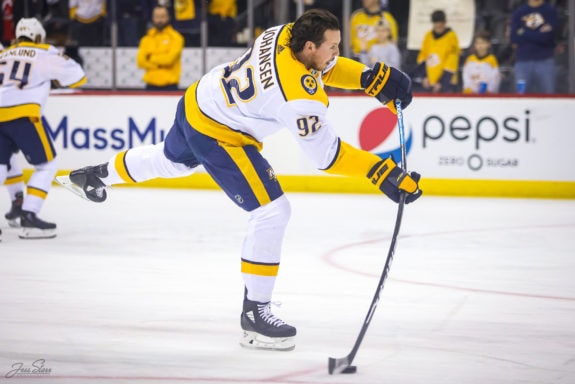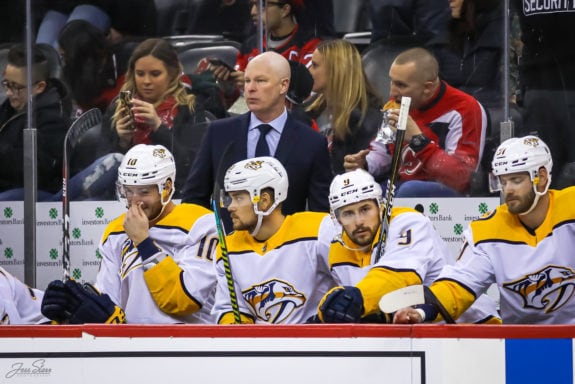Remember those Nashville Predators teams of the late 2000s and the early 2010s? They were usually a middle-of-the-pack type team, who had to scratch and claw their way into one of the final playoff spots, and if they could achieve that, it was a victory. The rosters were often underwhelming and nothing to shout about when it came to other teams in the league, but the former head coach, Barry Trotz got a lot out of them.
Well, it feels like Deja vu this season. The Predators are fighting to claim the last playoff spot and if they can secure it when the regular season comes to an end, it will be victory, considering how this year started out. The one thing that isn’t the same is the roster. As mentioned, the Predators of yesteryear were a scrappy and often overlooked group who overperformed many times. This season, the roster is far more impressive on paper and they should be one of the top teams in the league. Obviously, they’re not an elite or top team in the NHL, and what’s more, they’re underperforming to what they should be producing.
There’s another similarity that can’t be overlooked: The Predators’ lack of quality depth at the center position. For years they struggled to possess even one elite centerman. They were constantly undermanned and outmatched down the middle of the ice. So, much so that general manager David Poile seemed to make it his mission to rectify this, even if it meant trading a young, face of the franchise type potential player, who was perhaps the closest thing to a sure-fire future All-Star, for a centerman who had the ability to be the team’s number one.
As you’ve probably put it together by now, we’re talking about Seth Jones being sent to the Columbus Blue Jackets in exchange for Ryan Johansen. Sure enough, Jones did develop into an All-Star and still has the pedigree to be the face of a franchise. Whether that could be in Nashville is another debate seen as there’s a player by the name of Roman Josi residing in the Music City, but we digress.

So, Predators fans can party like it’s 2010 and rejoice in the fact that their team currently holds a playoff spot. But what does it matter when they’re still troubled by the same issue that’s crippled them for seemingly decades? When you have experience to the extent that a script is looking familiar, you also have the misfortune of knowing when something bad is coming. The Predators have tried to charge into the playoffs with questionable play at center and we know it doesn’t work. So how much optimism should there be when we’ve seen this movie several times before?
Those Who Don’t Learn Their History…
They made an impressive, but surprising run to the Stanley Cup Final in 2017 as everybody knows. It was maybe in someway the birth of the JOFA line, consisting of Johansen centering, Filip Forsberg, and Viktor Arvidsson. It had tremendous success, not only because the three were extremely cohesive for several series, and because Forsberg and Arvidsson found a scoring touch, but because the center position was solidified. There was finally a playmaker who the Predators could rely on, a centerman who could hold his own in the faceoff circle, helping the Predators start the right way on draws more often than not, and they had a forward who was strong in the defensive zone.
Related: Predators’ Blue Line on Verge of Being Overcrowded
Not to rehash old and painful history, but then Johansen went down with a serious lower-body injury in the Western Conference Final against the Anaheim Ducks, ending his season. The Predators managed to close out that series, but the loss of their number one center was especially telling in the Stanley Cup Final. The Predators seemed overwhelmed against the Pittsburgh Penguins. They no longer had an answer for some of the Penguins’ stars, matchups that Johansen would have been perfect for.
Fast forward to today. Johansen is still on the team, but arguably he’s a shell of who he once was, even for the Predators, and he is definitely not playing to the level that he is capable of.
Johansen is paid not only as the team’s top center but one of the league’s elite. According to CapFriendly, Johansen is the 15th highest paid centerman by cap hit. However, he ranks outside the NHL’s top-100 when it comes to points by his position.
When it comes to cost per point, the 28-year-old ranks as the 26th most expensive. He is even averaging just under $2 million per goal.
But it’s not just the point production that hurts. When it comes to faceoffs, Johansen is not exactly super dependable. According to Puck Base, he ranks 62nd leaguewide when it comes to draws in the offensive zone among players who reside in the top-100 of faceoffs taken, and 68th when lining up in the defensive zone.
When the Predators are on the powerplay, Johansen wins 58.5% of his faceoffs, which ranks 37th leaguewide. So, while the Predators are starting off with puck more often than not on the man advantage with Johansen at the helm, it’s not exactly elite, like $8 million per year elite.
The native of Vancouver, BC, has slowly seen his time on ice (TOI) decline since head coach John Hynes took over. Johansen is down almost two minutes per game from 2018-19. Not only has he seen a dip in ice time during the course of the game, but Hynes has also limited his playing time when shorthanded. During 2018-19 – Peter Laviolette’s last full season in charge of the Predators – Johansen averaged 1:26 TOI per game when his team was down a man. However, this season Johansen averages just 38 seconds while the Predators are penalty killing.

The reduced playing time in several situations really gives a sense of how the coaches view Johansen’s role or value, especially compared to the previous coaching staff. But it’s not like Hynes and his crew prefer to roll all four lines more. Johansen’s 19:33 average TOI in 2018-19 – his highest in the past five seasons – ranked 37th leaguewide among forwards. His ice time wasn’t exactly elevated, leaving nowhere to go but down. He was already playing less than his other top centerman counterparts from around the league.
The $56 Million Backfire?
Matt Duchene was acquired to compete for the top center spot, or at worst, make the second line as productive and effective as the first. It doesn’t seem fair to put his total stats from this season on trial, as they’ve obviously been hurt by the lengthy injury he is still currently dealing with.
But Duchene has suited up for a total of 89 games for the Predators. The 30-year-old has recorded 50 points, something that he’s usually had no problem surpassing during the course of a single season. Now, there could be a debate whether Duchene’s game has really dropped off, or if it’s the situation that he’s in. If Duchene were to return to say, the Blue Jackets or the Ottawa Senators, would he return to registering 70 points? Again, that could be its own conversation.
However, as it pertains to the Predators, it’s irrelevant. Even if Duchene is capable of recording 100 points in a season if it’s not while wearing a gold uniform, does it really matter? All we can do is address who Duchene is for the Predators, and who he is, isn’t someone who can put the team over the top when it comes to boasting the center position as a strength, well at least not by anything that he’s showed us thus far.

Outside of the team’s two highest-paid forwards, leaves an array of average players who are predominantly comfortable operating in the bottom six. This isn’t a knock against them, they play their roles well, but they need to be the depth, complementing players like Johansen and Duchene. Instead players such as, Mikael Granlund, Erik Haula, and Colton Sissons – three who have centered their respective lines for the past five games – are producing to the same level or even outperforming the Predators’ so-called “elite centers.”
Related: Predators’ Postseason Chances Have Improved in the Month of March
There’s a lot of good vibes surrounding the Predators right now and rightly so, they’ve won six games in a row. Not to dampen the mood, but they’ll have a tough road ahead of them to make the playoffs, like the Predators teams that came before them. If they can qualify for the postseason, they’ll be the underdogs playing against one of the league’s top teams due to seeding, like the Predators teams that came before them. And a first-round exit may be inevitable because they lack quality at one of the most important positions in hockey, and we know this because of the Predators teams that came before them.